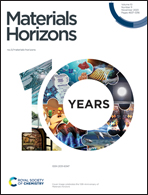A biocompatible pure organic porous nanocage for enhanced photodynamic therapy†
Abstract
Porphyrin-based photosensitizers have been widely utilized in photodynamic therapy (PDT), but they suffer from deteriorating fluorescence and reactive oxygen species (ROS) due to their close π–π stacking. Herein, a biocompatible pure organic porphyrin nanocage (Py-Cage) with enhanced both type I and type II ROS generation is reported for PDT. The porphyrin skeleton within the Py-Cage is spatially separated by four biphenyls to avoid the close π–π stacking within the nanocage. The Py-Cage showed a large cavity and high porosity with a Brunauer–Emmett–Teller surface area of over 300 m2 g−1, facilitating a close contact between the Py-Cage and oxygen, as well as the fast release of ROS to the surrounding microenvironment. The Py-Cage shows superb ROS generation performance over its precursors and commercial ones such as Chlorin E6 and Rose Bengal. Intriguingly, the cationic π-conjugated Py-Cage also shows promising type I ROS (superoxide and hydroxyl radicals) generation that is more promising for hypoxic tumor treatment. Both in vitro cell and in vivo animal experiments further confirm the excellent antitumor activity of the Py-Cage. As compared to conventional metal coordination approaches to improve PDT efficacy of porphyrin derivatives, the pure organic porous Py-Cage demonstrates excellent biocompatibility, which is further verified in both mice and rats. This work of an organic porous nanocage shall provide a new paradigm for the design of novel, biocompatible and effective photosensitizers for PDT.

- This article is part of the themed collection: World Cancer Day 2024: Showcasing cancer research across the RSC


 Please wait while we load your content...
Please wait while we load your content...